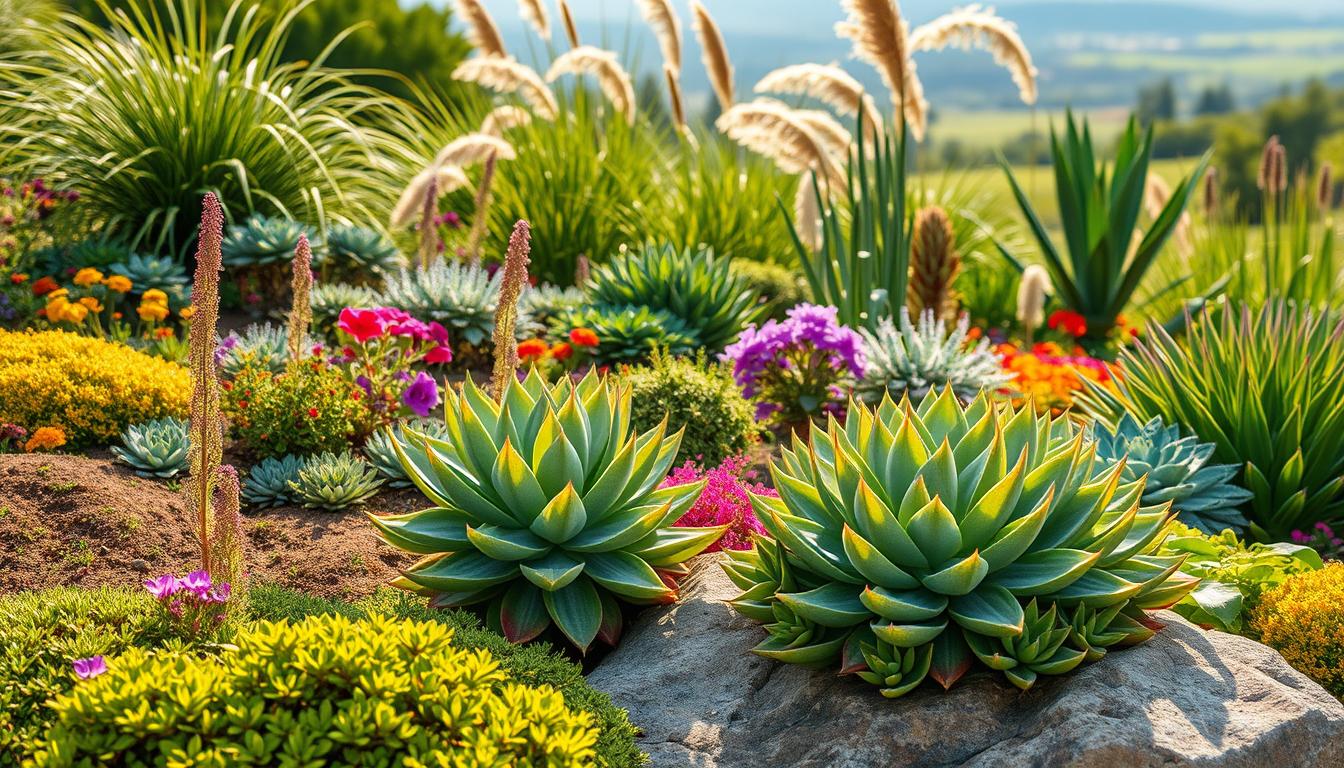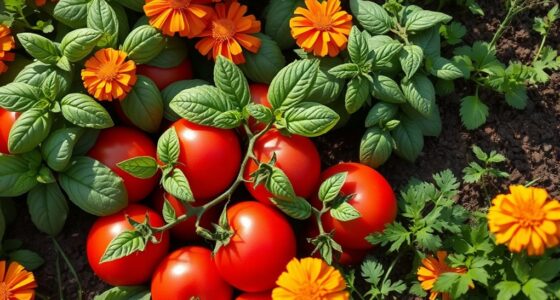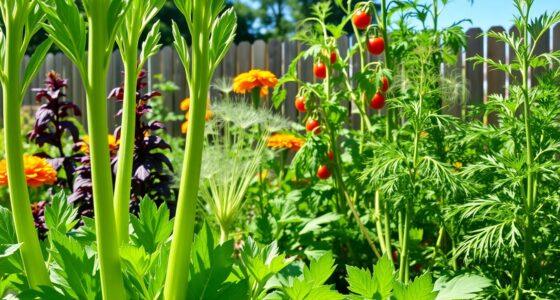Have you ever wandered through a garden and felt an overwhelming sense of peace, as though nature itself was wrapping you in a warm embrace? Perhaps you noticed those stunning, vibrant blooms of ice plants, their colorful petals dancing in the sunlight, beckoning you closer. These marvels of drought tolerance not only bring beauty to your landscape but also symbolize resilience and adaptability. By choosing the right ice plant companion plants, you can create a garden that shines with vitality while requiring low maintenance. In this article, we’ll dive into the best companions for your ice plants, ensuring your garden flourishes with ease and grace.
Key Takeaways
- Ice plants thrive in sunny, well-draining environments.
- Companion planting enhances the beauty and health of ice plants.
- Drought tolerant companion plants help maintain a sustainable garden.
- Choosing low maintenance plant companions allows for easier care.
- Pairing plants wisely can create a visually appealing landscape.
Introduction to Ice Plants
Ice plants, known for their striking visual appeal, are perennial succulents originating from Southern Africa. These plants thrive in various gardens, showcasing unique ice plant characteristics that make them a popular choice among gardeners.
What Are Ice Plants?
Ice plants are distinguished by their thick, fleshy leaves, which are adept at storing moisture. This adaptation allows them to survive in arid environments, making them highly drought-resistant. The vibrant blooms they produce in spring and summer add a dazzling touch to landscapes, bringing life and color to otherwise barren spots.
Benefits of Growing Ice Plants
There are numerous benefits of ice plants for your garden. Not only do they require minimal maintenance, but they also offer an excellent solution for water-wise gardening strategies. Their ability to flourish with limited watering means more time enjoying your garden and less time tending to it. Such qualities make ice plants a great addition for both novice and experienced gardeners alike.
Ideal Growing Conditions
To ensure the best growth, understanding ice plant growing conditions is crucial. These plants thrive in full sun and prefer well-draining soils. Sandy or rocky substrates are ideal, typically found in hardiness zones 5-9. Their adaptability allows them to flourish in various soil types, as long as moisture is not excessive. By providing the right environment, you can enjoy a thriving display of ice plants in your garden.
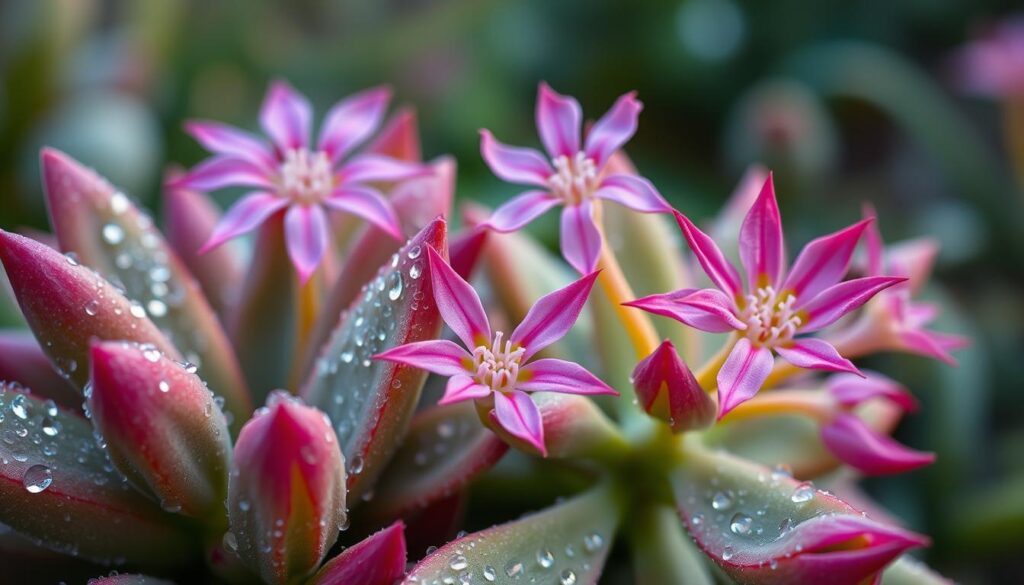
Companion Planting Basics
Companion planting involves strategically placing different plants together to enhance growth and health. This method not only promotes a harmonious garden but also utilizes space and resources efficiently. Understanding the companion planting benefits can transform your gardening techniques, making your garden more productive and enjoyable.
What Is Companion Planting?
Companion planting is the practice of pairing plants that complement each other’s growth. This could involve planting species that deter pests or those that can help another absorb nutrients effectively. By embracing this technique, you can create a thriving garden ecosystem that requires less maintenance and offers greater yields.
Benefits of Companion Plants
The advantages of using companion plants in your garden abound. Improved pest control, enhanced nutrient uptake, and increased attractiveness to pollinators are just a few. Companion planting techniques can also reduce your need for chemical fertilizers and pesticides, promoting a healthier environment for both the plants and the gardener.
How to Choose the Right Companions
Choosing companion plants requires careful consideration. Start by assessing the light, water, and soil requirements of each plant. Look for varieties that share similar needs, but also consider visual aspects like contrasting heights and colors for added aesthetic appeal. Engaging in this thoughtful selection will elevate your gardening experience and result in a flourishing garden.

Popular Companion Plants for Ice Plants
Finding the right ice plant companions can enhance your garden’s beauty while providing them with benefits such as increased moisture retention and pest deterrence. Select plants that thrive in similar conditions, especially those that remain drought-tolerant. Here are some top choices to consider for your garden.
Sedum Varieties
Sedum varieties, including ‘Autumn Joy’ and ‘Sedum rupestre’, are excellent succulent partners due to their resilience and adaptability. These plants flourish in dry, sunny environments, providing a harmonious aesthetic alongside your ice plants. Their similar maintenance requirements make them ideal companions, creating a seamless blend in your garden.
Agave Species
Agave species are known for their striking architectural forms, which pair beautifully with the low-growing ice plants. These drought-tolerant plants thrive in similar conditions, offering a visually appealing contrast. Their robustness not only complements the ice plants but also enhances the desert landscape feel, making your outdoor area striking.
Lavender Plants
Incorporating lavender into your garden adds a delightful fragrance while attracting pollinators. These drought-tolerant plants help create a vibrant ecosystem that benefits your ice plants. The presence of lavender can also deter pests, providing an additional layer of protection for your succulent partners.
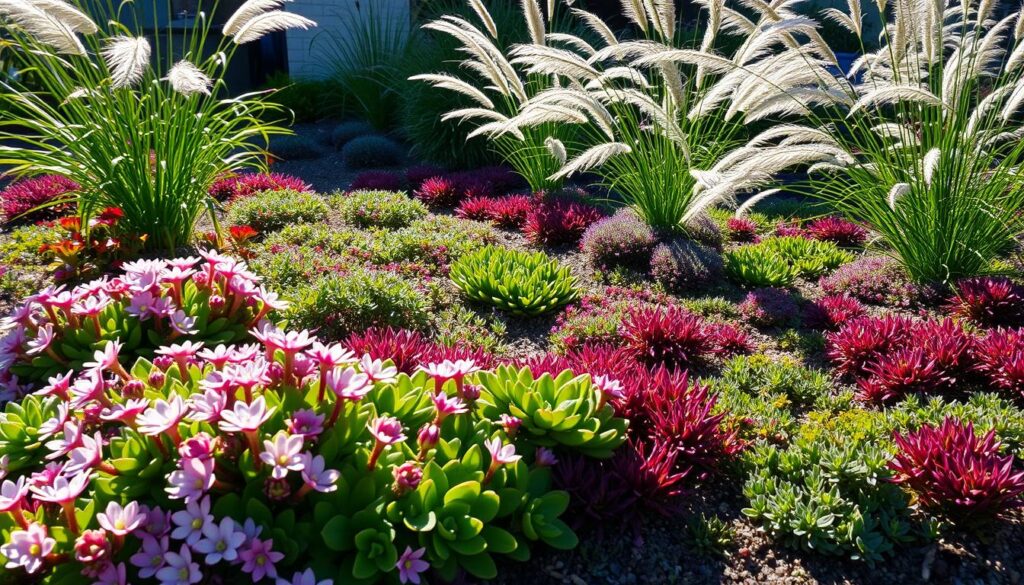
| Companion Plant | Benefits | Growing Conditions |
|---|---|---|
| Sedum Varieties | Susceptible to drought, visually appealing | Full sun, well-drained soil |
| Agave Species | Architectural interest, drought-resistant | Full sun, minimal watering |
| Lavender | Fragrant, pest deterrent | Well-drained soil, full sun |
Choosing the right companions enhances the garden’s aesthetic while ensuring that your ice plants receive the appropriate care they need. By selecting sedum, agave, and lavender, you cultivate a thriving and visually appealing space that showcases the beauty of drought-tolerant plants.
Flowering Companions for Aesthetic Appeal
Integrating flowering companions for ice plants enhances the overall beauty of your garden. These plants not only complement the unique texture of ice plants but also create dynamic visual interest. Choosing the right flowering companions involves considering their bloom times, colors, and how they work together in seasonal gardening.
List of Flowering Companions
- Yarrow
- Vinca
- Flowering Quince
Yarrow provides feathery foliage that contrasts nicely with the thicker leaves of ice plants. Vinca’s ability to produce flowers consistently from spring through fall makes it a versatile choice. Flowering quince adds vibrant pops of color, enhancing the aesthetic appeal of your garden.
Best Colors to Pair with Ice Plants
Engaging in color pairing in gardens can significantly affect your garden’s visual appeal. Pair the striking colors of ice plant flowers with vibrant purples from lavender and yarrow. These combinations create a lively atmosphere, ensuring that your garden captures attention throughout the seasons.
Seasonal Blooming Considerations
Incorporating plants that bloom at staggered intervals plays a crucial role in seasonal gardening. Strategically selecting flowering companions for ice plants that bloss distinctly over spring, summer, and fall ensures a continuous display of color. This approach maintains interest in your garden, enticing visitors and pollinators alike.
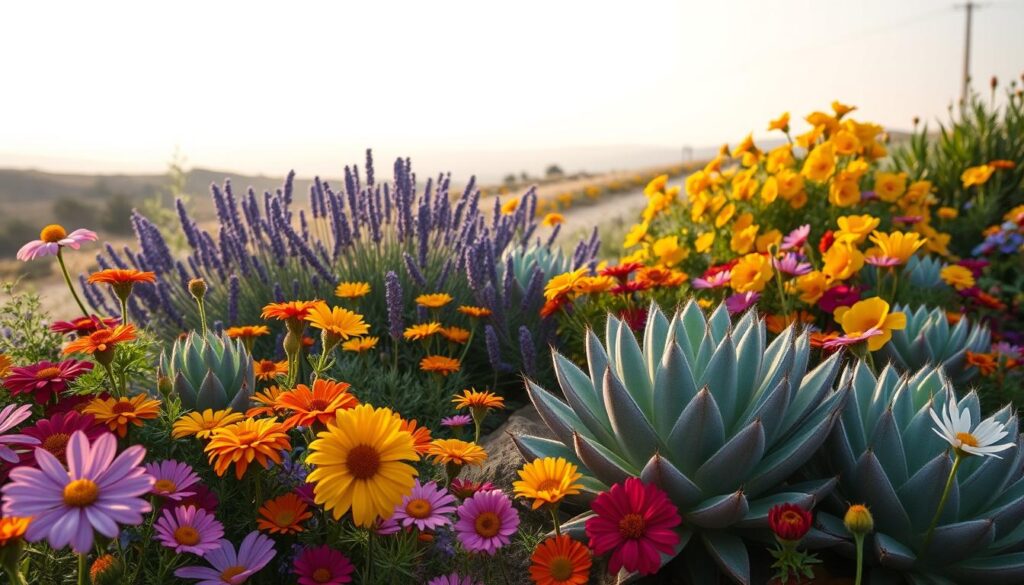
| Flowering Companion | Bloom Time | Color |
|---|---|---|
| Yarrow | Summer | Yellow, White, Pink |
| Vinca | Spring to Frost | Blue, Pink, White |
| Flowering Quince | Early Spring | Red, Pink, Orange |
Drought-Tolerant Companions
Incorporating moisture-resistant companions into your garden not only enhances its beauty but also promotes sustainability. Choosing drought-tolerant garden plants can significantly reduce water consumption while still providing a vibrant landscape. The right selection of plants can thrive in similar dry conditions as ice plants, making them ideal partners.
Why Drought Tolerance Matters
Drought tolerance is essential for gardeners aiming to create eco-friendly landscapes. As water resources become more limited, selecting drought-resistant species helps maintain beautiful gardens without excessive water consumption. By prioritizing these plants, you contribute to environmental sustainability and reduce maintenance efforts.
Best Drought-Resistant Plants
- Sedum: This succulent thrives in dry conditions, adding texture and color.
- Lavender: Known for its fragrance, it requires minimal water and attracts pollinators.
- Yucca: A striking plant that offers architectural interest while thriving in arid soils.
- Ornamental Grasses: These add movement and variety without needing much moisture.
Examples of Succulent Companions
Drought-resistant succulents provide a range of options to complement ice plants beautifully. Consider the following:
| Succulent Name | Sun Requirements | Water Needs |
|---|---|---|
| Hens and Chicks | Full Sun | Low |
| Jade Plant | Partial Sun | Moderate |
| Agave | Full Sun | Very Low |
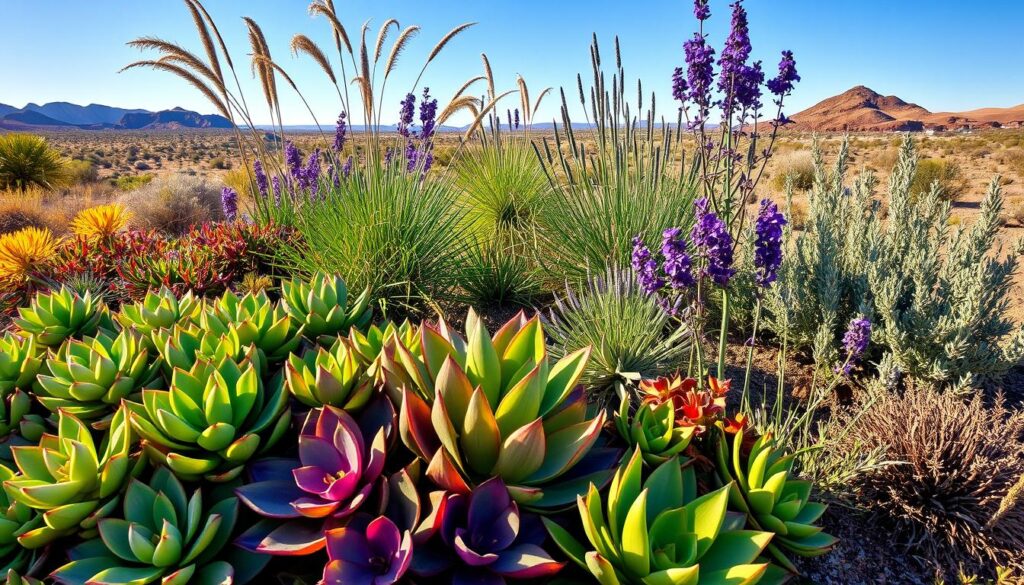
Herbs That Pair Well with Ice Plants
Integrating herbs into your garden can elevate both visual aesthetics and functionality. When selecting herb garden companions for ice plants, consider options that flourish in similar environments. Herbs like lavender, sage, and rosemary stand out for their compatibility and appeal.
Popular Herb Choices
- Lavender: Known for its delightful fragrance and vibrant flowers.
- Sage: Offers a robust flavor for culinary uses, while being visually appealing.
- Rosemary: A hardy herb that thrives in well-drained soil and plenty of sunlight.
Growing Conditions for Herbs
The growing conditions for herbs closely align with those preferred by ice plants. These herbs typically flourish in sunny areas with well-draining soil. Ensure adequate spacing between plants to promote airflow and reduce competition for nutrients. Watering should be minimal, as many herbs thrive in drier conditions.
Culinary Uses of Companion Herbs
Using these culinary herbs in your kitchen adds flavor and freshness to your meals. Lavender can be used in desserts, sage complements meats, and rosemary enhances roasted vegetables. The combination of beauty, fragrance, and culinary potential makes these herbs invaluable companions in your garden.
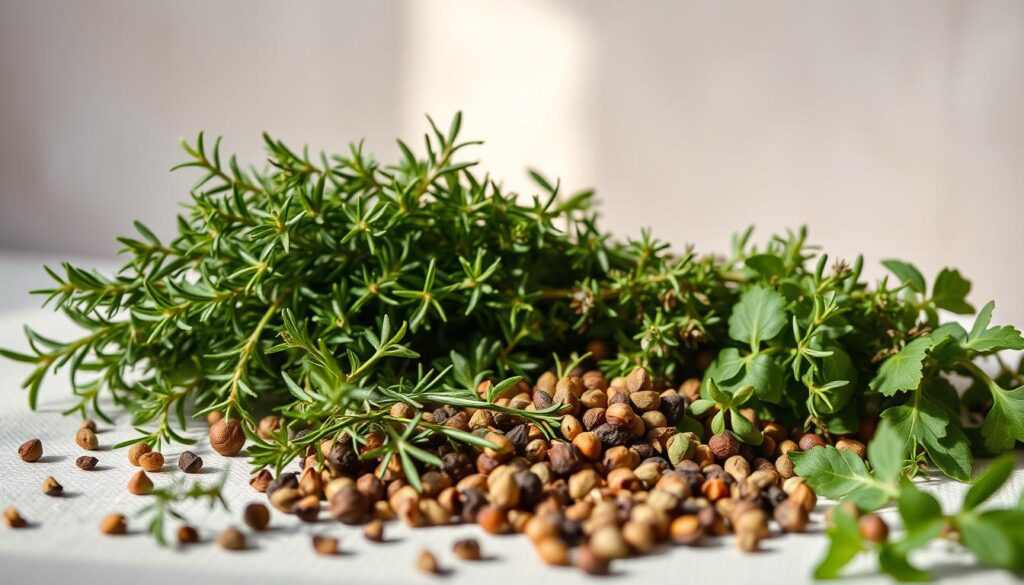
Ground Cover Plants to Consider
Incorporating ground cover plants into your landscape design not only enhances the aesthetic appeal but also provides numerous benefits for ice plant ground cover. These plants serve as excellent companions for ice plants, creating a lush and vibrant environment.
Best Ground Cover Companions
Some top choices for ground cover plants include:
- Creeping Thyme
- Phlox
- Low-Growing Sedums
Each of these options integrates beautifully with ice plants, bringing texture and color to your garden while being low maintenance.
Creating a Balanced Landscape
When planning your landscape design, consider the layering effect achieved by pairing lower ground cover plants with taller varieties. This combination builds visual interest and maintains a healthy balance within your garden. Such thoughtful arrangements also support better light distribution and airflow among plants.
How Ground Covers Benefit Ice Plants
Ground cover plants actively contribute to the vitality of ice plants by:
- Suppressing weeds, reducing competition for nutrients.
- Improving soil health through organic matter addition.
- Retaining soil moisture, essential for ice plant growth.
By incorporating these elements, you foster a thriving garden ecosystem that supports the beauty and longevity of your ice plants.
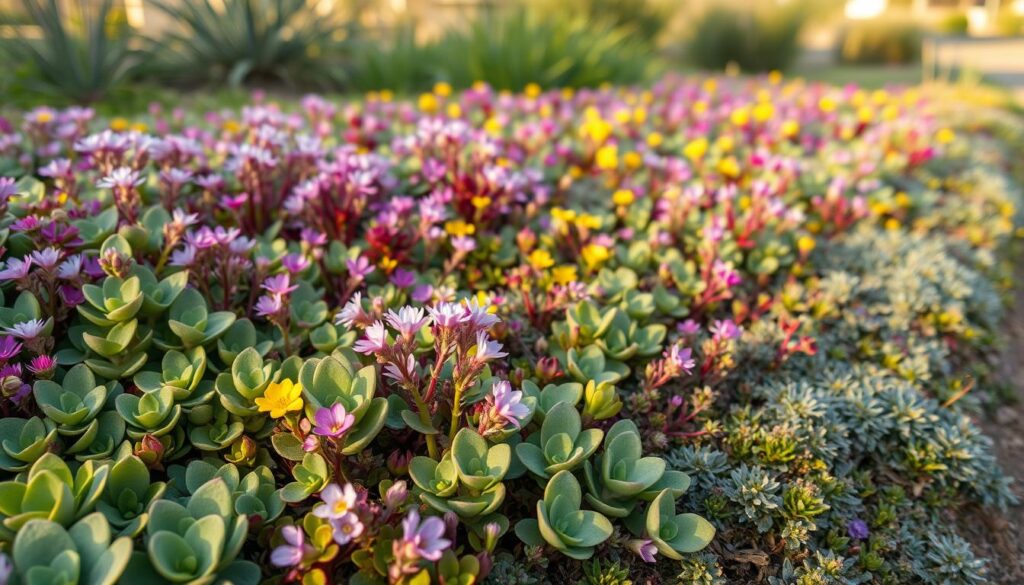
Attracting Pollinators with Companion Plants
Creating a garden rich in biodiversity involves incorporating pollinator-friendly plants to attract beneficial insects. Companion plants can play a crucial role in supporting the population of bees and butterflies, essential for maintaining a healthy ecosystem. By carefully selecting these plants, you enhance not only the beauty of your garden but also its ecological value.
Best Plants for Pollinator Attraction
- Lavender – Known for its fragrant flowers and nectar-rich blooms, this plant attracts various pollinators.
- Yarrow – Its flat-topped flowers provide an easy landing pad for bees and butterflies.
- Sunflower – A towering giant that delights in drawing in all types of pollinating insects.
- Bee Balm – With vibrant blooms, it serves as a favorite among many bee species.
- Echinacea (Coneflower) – Offers a reliable source of nectar throughout the growing season.
Seasonal Blooming Cycles
Incorporating plants with staggered blooming cycles ensures your garden remains a haven for pollinators year-round. Selecting a variety of species that bloom in different seasons allows you to provide a continuous food source. Consider using:
| Season | Plant Examples | Attracted Species |
|---|---|---|
| Spring | Chives, Bluebells | Early bees, butterflies |
| Summer | Lavender, Sunflowers | Honeybees, Monarchs |
| Fall | Asters, Goldenrod | Late-season pollinators |
Creating a Pollinator-Friendly Space
To effectively create a pollinator-friendly space, aim for a variety of shapes and heights in your plant choices. Grouping flowers in clusters attracts more pollinators as they prefer to forage in patches. Additionally, steering clear of pesticides protects the delicate balance of your garden’s biodiversity. By promoting a welcoming environment, you encourage not just bees and butterflies but a spectrum of beneficial insects that enhance plant health.
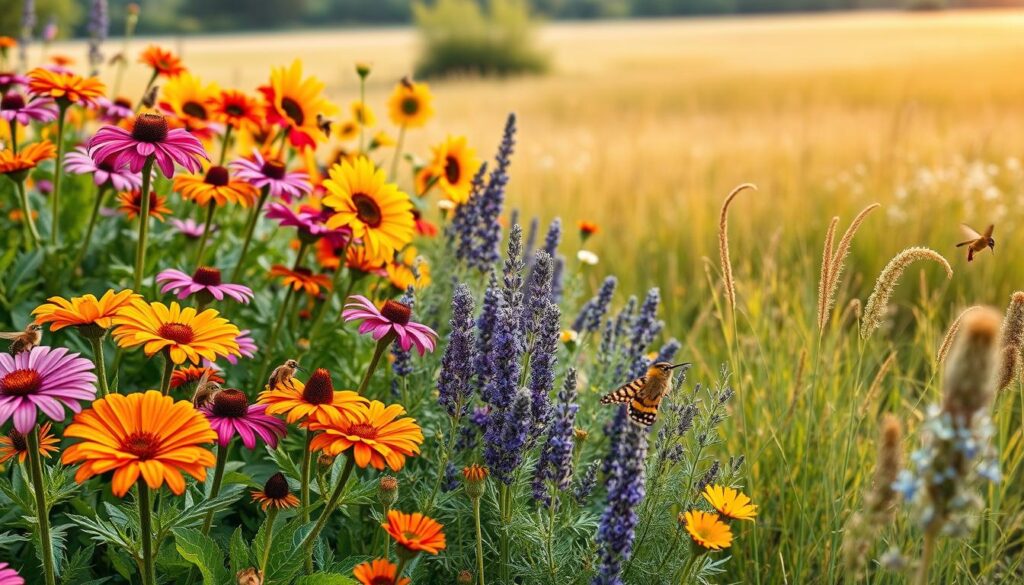
Edible Plants as Companions
Incorporating edible plants alongside ice plants can enhance your garden’s functionality and aesthetics. These companions, including cherry tomatoes, peppers, basil, and parsley, thrive together by sharing similar watering needs and light exposure. Understanding which edible plants grow harmoniously can lead to a thriving garden full of flavor and nutrients.
Which Edible Plants Grow Well Together?
Several edible plants flourish when planted near each other. For instance, the combination of tomatoes and basil is not only effective for pest control but also elevates the flavor of culinary dishes. Peppers and onions also make great companions, promoting a productive garden while ensuring mutual growth benefits.
Gardening Tips for Edible Companions
Successful gardening with edibles requires proper techniques. Here are some essential gardening tips for edibles:
- Ensure well-drained, nutrient-rich soil.
- Space plants adequately to allow airflow and minimize competition for resources.
- Rotate crops yearly to maintain soil health and avoid pests.
Regular observation of your plants aids in effective pest management, allowing you to maintain a thriving garden ecosystem.
Nutritional Benefits of Edible Pairings
Combining different edible plants not only diversifies your garden but also enriches your meals. The nutritional benefits of these pairings can enhance your culinary experience, bringing variety to your diet. For example, tomatoes paired with basil not only taste fantastic but also create a dish loaded with vitamins and antioxidants. Planting a mix of herbs along with fruits and vegetables enhances overall health benefits.

Landscape Design Ideas with Ice Plants
Ice plants serve as an excellent choice for enhancing your landscape design due to their vibrant blooms and low-growing habit. Incorporating them into your garden layout not only adds color but also offers practical benefits, especially in rock gardens.
Creating a Stunning Rock Garden
Rock gardens are ideal for ice plants, as their ground-hugging nature complements rocky terrain. You can create a stunning display by layering gravel or boulders, interspersed with diverse plant species. This setup provides both structure and visual interest in gardening, enabling ice plants to thrive among other drought-tolerant varieties.
Designing with Color and Texture
When planning your garden layout, consider contrasting colors and various textures. Grouping ice plants with plants that have different foliage types can add depth to your design. For instance, pairing the vibrant pinks and yellows of ice plants with the soft blue hues of succulents enhances the overall appeal, allowing each element to shine.
Layering Plants for Visual Interest
To further enrich your landscape, use layering as a technique. Place taller plants in the back, medium-sized ones in the middle, and ice plants or other ground covers in the front. This strategy not only improves visual interest in gardening but also ensures that every plant gets the light and space it needs to flourish.
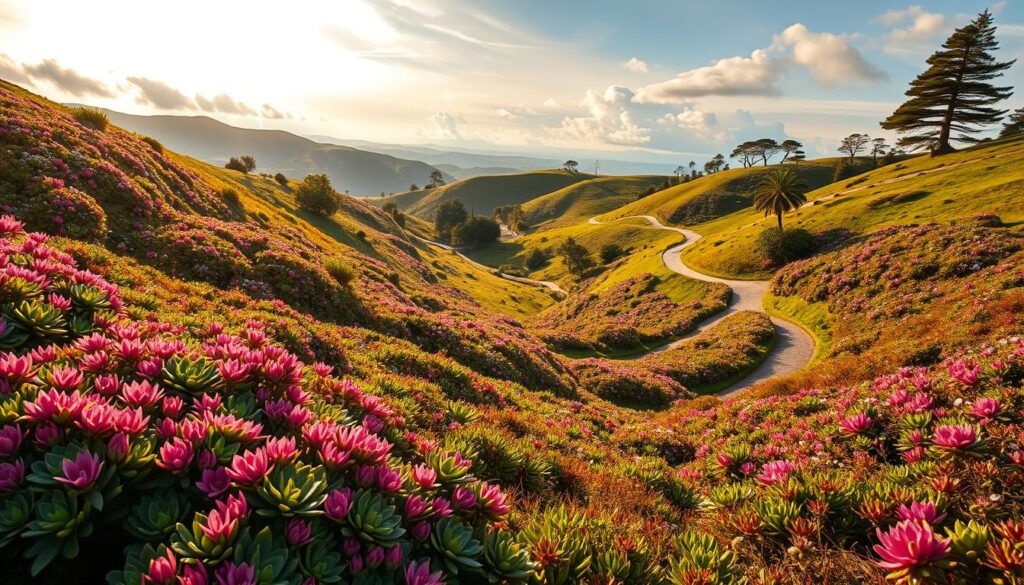
Implementing these landscape design ideas will transform your garden into a stunning oasis that showcases the beauty of ice plants. Your careful arrangement will result in a harmonious outdoor space where vibrant colors and interesting textures create visual delight.
Options for Container Gardening
Container gardening is a wonderful way to showcase ice plants while maintaining flexibility and style. Choosing the right container is essential for the healthy growth of your potting plants. Let’s explore some suitable containers, the best companion plants for pots, and essential care tips for container gardens.
Suitable Containers for Ice Plants
When selecting containers for your ice plants, consider options that promote excellent drainage and airflow. Terracotta pots are a popular choice because their porous material allows moisture to escape, helping prevent root rot. Plastic or ceramic planters specifically designed for succulents can also work well, as they often include drainage holes tailored for this purpose.
Best Companion Plants for Pots
Incorporating companion plants in your container garden enhances aesthetics and can improve plant health. Some excellent options for potting plants alongside ice plants include:
- Sedum varieties: These hardy succulents thrive in similar conditions as ice plants.
- Geraniums: Their vibrant blooms create a striking color contrast with ice plants.
- Vinca: This flowering plant with its rich foliage complements the textures of ice plants beautifully.
Care Tips for Container Gardens
To ensure your container garden thrives, follow these care tips for container gardens:
- Regularly monitor soil moisture. Allow the top layer of soil to dry out before watering.
- Ensure proper drainage. Check that containers have adequate holes to prevent excess water buildup.
- Avoid overwatering, which can lead to root rot and other issues.

Common Mistakes to Avoid in Companion Planting
Engaging in companion planting can yield spectacular results, but certain gardening mistakes often hinder success. Recognizing common pitfalls will help you improve your gardening care routine and enhance your experience. Let’s explore some of the most frequent errors and how to avoid them.
Overcrowding Issues
One significant issue you may encounter is overcrowding. When plants are too close together, they compete for essential resources such as sunlight, nutrients, and water. This not only stunts their growth but can lead to increased susceptibility to pests and diseases. Adhere to recommended spacing guidelines from gardening tips to prevent overcrowding and ensure each plant thrives.
Watering Missteps
Watering can be tricky, with many gardeners committing missteps here. Over or under-watering can lead to root rot or desiccation. Implement a consistent watering schedule that aligns with the needs of your plants. Companion planting tips often emphasize the importance of understanding moisture requirements. Focus on observing your garden regularly to make adjustments based on weather conditions.
Choosing Companions with Conflicting Needs
Selecting plants that have contrasting care requirements can drastically impact your gardening results. Pairing a moisture-loving plant with a drought-resistant one, such as ice plants, can jeopardize their health. Be mindful of environmental needs and choose companions that harmonize in terms of watering and light preferences. This awareness promotes strong growth and reduces the risk of failure.

How to Care for Your Ice Plants and Companions
Caring for your ice plants and their companions involves understanding several key aspects of their growth requirements. Ice plant care focuses on appropriate watering techniques, soil quality, and pest management for gardens. By integrating these elements, you can ensure a thriving garden full of vibrant colors and healthy plants.
Watering Tips for Survival
Effective watering techniques are crucial for the health of ice plants. These succulent varieties require less frequent watering, typically every two weeks. Overwatering can lead to root rot, so it’s essential to observe your plants and water them only when the soil is dry a few inches down. Adjust your schedule based on seasonal changes, as plants may require more hydration during hotter months.
Importance of Soil Quality
Soil quality plays a vital role in ice plant care. These plants thrive in sandy, well-draining soils that prevent moisture retention. A mix of potting soil with sand or perlite ensures good drainage. Keeping the soil loose aids root development and promotes better access to nutrients, guiding your plants towards robustness and vibrancy.
Pest Management Strategies
Pest management for gardens housing ice plants involves natural strategies to keep unwanted insects at bay. Companion planting can be an effective way to deter pests naturally. Consider integrating herbs like basil or marigolds, which can repel common garden nuisances. Regular monitoring and easy maintenance can help you preserve a healthy gardening environment.
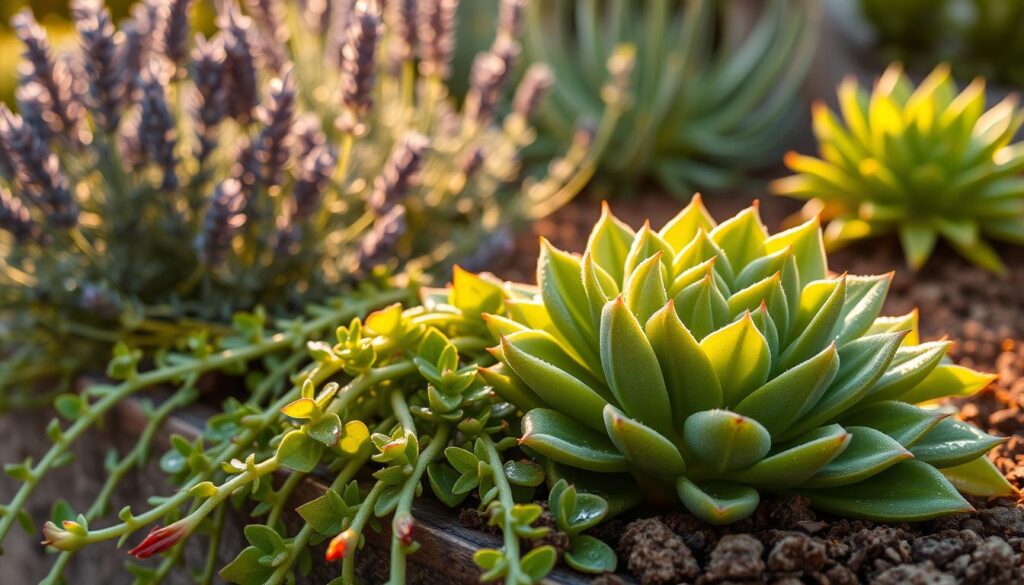
Seasonal Care and Maintenance
Maintaining your ice plants involves mindful seasonal garden care to ensure they thrive throughout the year. Having a solid care checklist for each month can help you manage growth effectively and prepare your garden for any changes in weather.
Monthly Care Checklist
Each month, focus on tasks that promote healthy plant growth. Consider these key activities:
- Monitor soil moisture levels to prevent both overwatering and drought stress.
- Prune spent flowers to encourage new blooms and maintain plant aesthetics.
- Inspect for pests and diseases to catch any problems early.
This systematic approach to seasonal garden care will keep your ice plants vibrant and healthy.
Preparing for Winter
Winter preparation for gardens is crucial for ice plants, especially in regions with cold temperatures. Here are some effective strategies:
- Insulate pots with materials like burlap or straw to protect roots from freezing.
- Apply a layer of mulch around the base of the plants to retain warmth and moisture.
- Position potted plants in sheltered areas to reduce exposure to harsh winds.
These actions will help your plants withstand winter’s chill.
Spring Planting Tips
Spring is the perfect time to rejuvenate your garden and prepare for new growth. Incorporate the following tips into your routine:
- Choose the right planting schedule to coincide with the last frost date in your area.
- Consider adding compost to enrich the soil, promoting robust growth.
- Space your plants appropriately to allow for expansion and air circulation.
With careful planning, your ice plants and companions will flourish come spring.
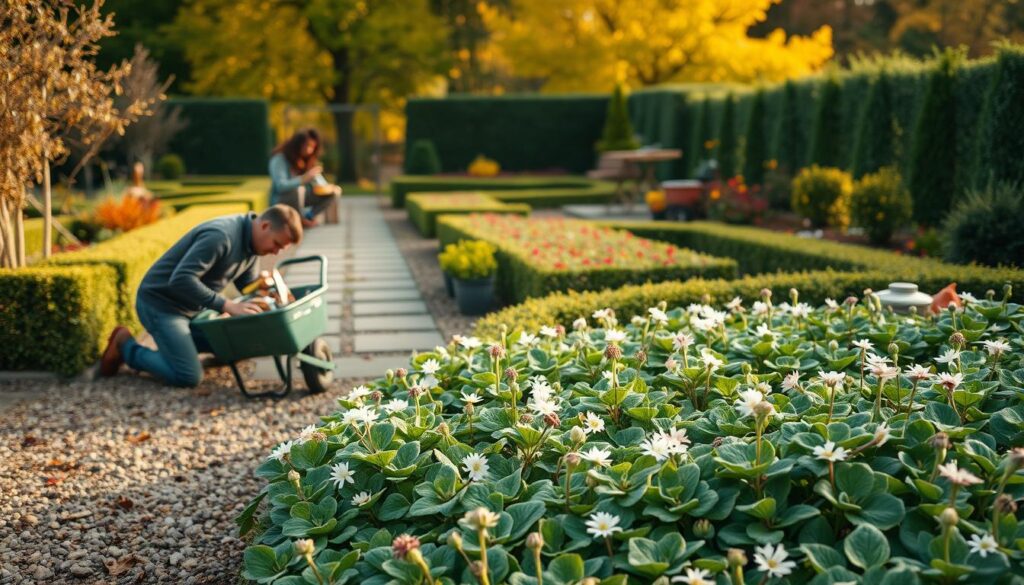
Conclusion
As we’ve explored in this article, the companion planting benefits of integrating ice plants with other species can greatly enhance your garden’s overall health and aesthetic appeal. These resilient plants not only provide a delightful splash of color but also contribute to better pest control and soil health. A well-planned combination of companions can transform your outdoor space into a thriving ecosystem.
Gardening is a journey of garden experimentation; don’t hesitate to try various plants alongside your ice plants. Each combination can yield unique results that benefit both your plants and your landscape design. Observing these interactions is part of the joy of gardening, allowing you to make adjustments that suit your particular environment.
Ultimately, an ice plants overview reveals their versatility and charm, making them an excellent choice for both novice and experienced gardeners. Cultivating these stunning plants with thoughtful companions not only enriches your gardening experience but also enhances the beauty of your outdoor spaces. Embrace the exploratory nature of gardening, and enjoy the rewarding journey of creating your ideal landscape.
